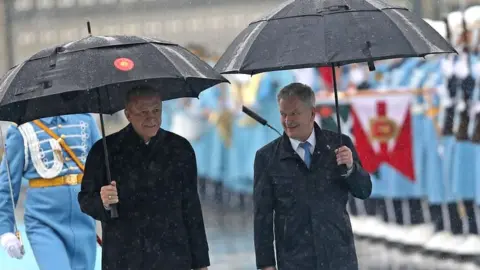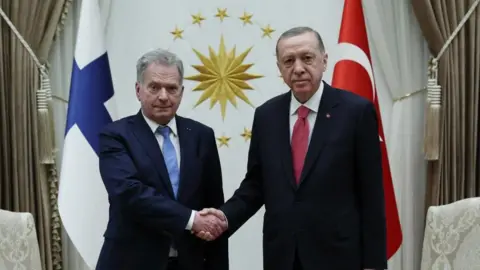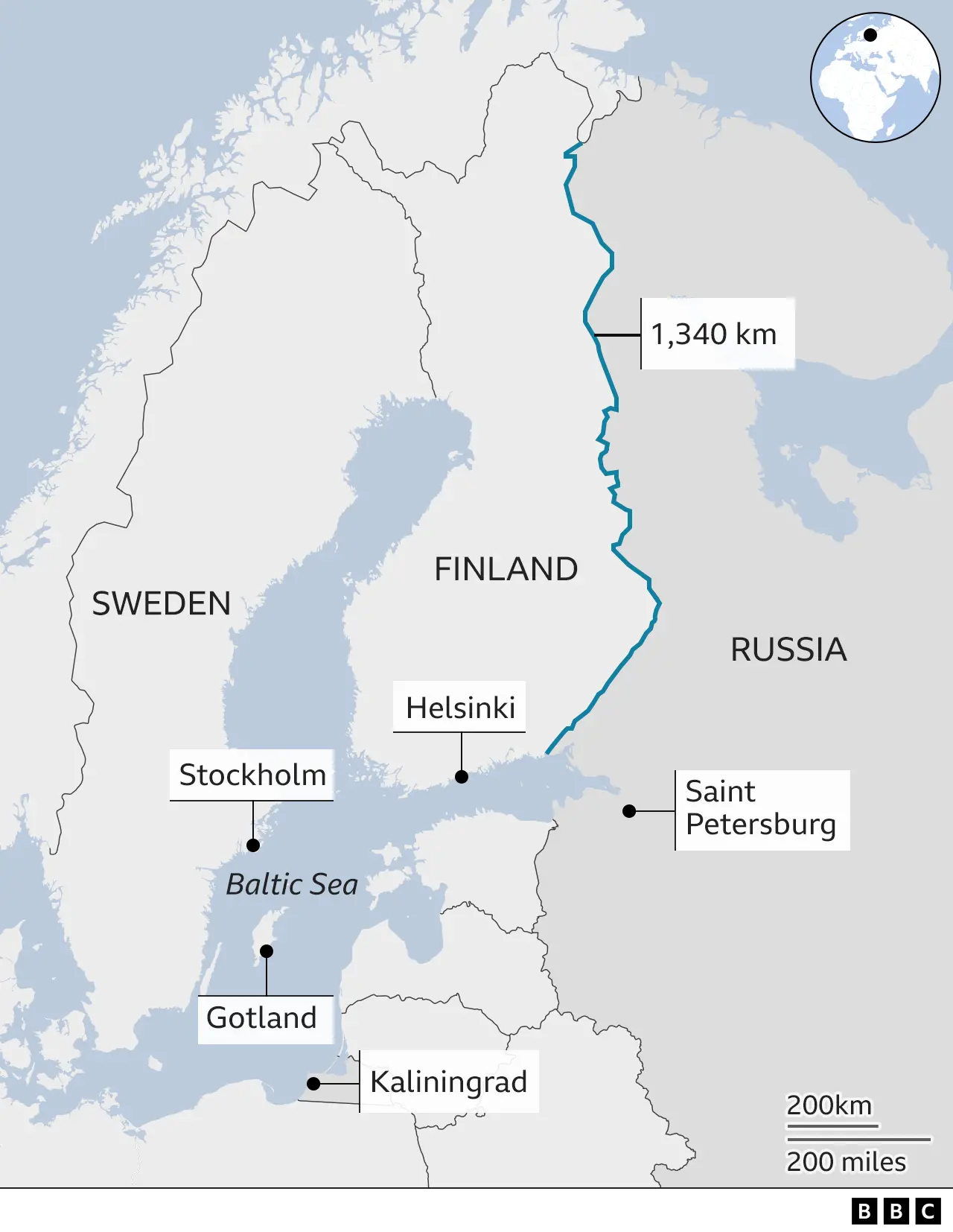Turkey's Erdogan seals deal on Finland joining Nato
 NECATI SAVAS/EPA-EFE/REX/Shutterstock
NECATI SAVAS/EPA-EFE/REX/ShutterstockFinland's bid to join Nato has finally secured the backing of Turkish President Recep Tayyip Erdogan.
Turkey had blocked Finland's application for months, complaining it had supported "terrorists".
At a press conference in Ankara with his Finnish counterpart, Mr Erdogan praised Finland's "authentic and concrete steps" on Turkish security.
Any Nato expansion needs the support of all its members - and Finland is now a step closer to joining.
A vote will go to Turkey's parliament to approve its application.
Finland, which neighbours Russia, applied with Sweden to join the West's defensive alliance last May.
Both were held up by Turkish objections - but Mr Erdogan is still refusing to support Sweden. Finland has decided to push ahead alone.
The blue carpet was rolled out for Finland's President Sauli Niinisto as he arrived at the presidential palace in pouring rain.
But President Erdogan's hostility to Sweden was clear as the two leaders addressed reporters. He said Sweden had embraced Kurdish militants, labelling them "terrorists". He complained that Kurdish militant demonstrations had been allowed on the streets of Stockholm.
Swedish Foreign Minister Tobias Billstrom said afterwards it was "a development we did not want, but were prepared for". It was still a matter of when, not if, Sweden joined Nato, he added.
Finland and Sweden abandoned their traditional military neutrality in response to Russia's full-scale invasion of Ukraine. Almost overnight, support for Nato membership leapt from an underwhelming one-third of Finns to almost 80%.
Both countries still aim to be part of Nato in time for a July summit in Lithuania. But any new member has to secure the approval of all 30 Nato members.
Turkey is facing presidential and parliamentary elections on 14 May. Assuming the parliament ratifies Finland's accession beforehand, the government in Helsinki still has to secure the support of Hungary.
However, Hungary's ruling Fidesz party said on Friday that a vote would take place in parliament in Budapest on 27 March and that it would vote yes. A leading party figure said a decision on Sweden would take place "later".
 EPA-EFE/REX/Shutterstock
EPA-EFE/REX/ShutterstockMr Niinisto told reporters as he stood alongside the Turkish leader that the process of joining the alliance would "not be complete without Sweden" and he hoped to see both countries in Nato in time for the Vilnius summit.
Sweden's talks with Turkey were put on hold for several weeks recently, after a Koran was burnt outside the Turkish embassy in Stockholm by a far-right Danish politician, who has denied links to Russian extremists.
President Erdogan said that Sweden's prime minister, Ulf Kristersson, was a "nice person" but Ankara had asked his government to extradite some 120 figures who had yet to be sent to Turkey.
Since Russia's invasion began in February 2022, Finland has sought to strengthen its eastern border.
Close to the border, in Lappeenranta, you can see for yourself why Finland feels so exposed. The dividing line stretches 1,340km (832 miles) from the Gulf of Finland in the south to the Arctic far north.
It is the longest border with Russia in the European Union. Wild pine forests sprawl on both sides, making it fiendishly hard to police and protect. Finland has begun building a 200km fence to beef up security.
Finland has a long and difficult history with its neighbour. It was swallowed whole by Russia in the early 19th Century, becoming independent after the Russian Revolution of 1917, only to be invaded by the Soviets in 1939.
No-one has ever taken peace for granted. Finland has a labyrinth of underground war bunkers.
As an insurance policy, Helsinki tiptoed around Russia for decades in its foreign, and even domestic policies.
Since 1994 both Finland and Sweden have been official Nato partners and have taken part in Nato missions since the Cold War. But Finland decided it was best to keep out of Nato, until Russia's war in Ukraine.
Finns see themselves as pragmatic and now believe their national security is better guaranteed inside, rather than outside the alliance.
Finland's population of 5.5 million is smaller than Sweden's, but it has a well-funded defence with a wartime military force of 280,000 and another 870,000 reservists.
Sweden has in recent decades spent less on defence, but has aimed to reach Nato's target of 2% of its economic output by 2026, with conscript numbers of 24,000 in 2025 and 50,000 in 2035.
Last month, Sweden's military intelligence and security service (Must) said the security threat was the most serious since the start of the 1980s and there was a tangible military threat from Russia.
The head of Must, Lina Hallin, said Russia's military currently had limited capabilities towards Sweden's immediate area but it would be able to learn lessons from the Ukraine war and strengthen its military presence.


